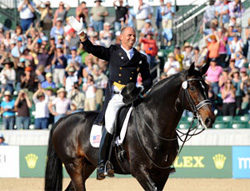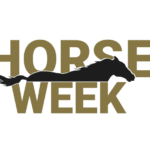March 6, 2010 — Nations’ Cup night is always one of the highlights of the FTI Winter Equestrian Festival, but this year the crowd of 8,300 at the Palm Beach International Equestrian Center seemed even more revved up than usual.
Flags, face painting and “vocal encouragement” super-charged the atmosphere yesterday as Canada took the title for the fifth time in nine years, while the home side finished out of the medals in a disappointing but not unexpectedly weak performance.

The best American horses are competing in the Alltech FEI World Equestrian Games trials here, so the squad had to field what amounted to spares; mostly mounts not up to the level of experience needed to triumph in the test set under the lights by course designer Anthony D’Ambrosio Jr.
The U.S. total of 31 faults was two penalties behind the third-placed squad of American-based Irish riders. Runner-up Mexico showed its strength with a 13-fault performance, while Canada had only 5 penalties.
The U.S. will have to beware of Canada at the WEG; its veteran Ian Millar wasn’t even on this squad, as he didn’t have a horse ready for last night’s effort, and individual gold medalist Eric Lamaze was aboard Ronaldo rather than his 2008 Games horse, Hickstead.
The Canadians, the silver medalists at the Hong Kong Olympics, can always be regarded as a threat these days, but now the U.S. has something else to worry about: Mexico.
Norman Dello Joio, the USA’s Olympic individual bronze medalist from 1992, is coaching Mexico and he told me they left two top riders home! He thinks the nation is ready for a WEG medal, with lots of assets including one of the world’s best horses, Presley Boy (Thursday’s WEF class winner), whose rider, Jaime Azcarraga, rode another mount, Celsius, in the Cup.
Low-key Norman is among the best of horsemen, and when he makes a prediction, watch out. I’ve never found him to say things lightly.
“Mexico has gone back to my era of General Mariles, which was invincible,” said U.S. coach George Morris, recalling the days in the 1950s and ’60s when the USA’s show ring border battles were with Mexico as well as Canada.
Canadian chef d’equipe Torchy Millar noted his squad points toward the Cup.
“It’s the highlight of the winter for us,” he said.
“We have a lot of fans that come down from Canada just to see this event. So we always try to put our best foot forward here and luckily we have four great riders on the team.”
One of the challenges of the Cup course was the fact that a black-and-white triple bar was set near the in-gate. Some horses seemed to think they were finished at that point, yet they still had to turn and tackle a triple combination, 11ABC before they got to the CN oxer, the final fence, at the opposite end of the ring. After two rounds over the same route, that got tiring.

The U.S. actually was in the hunt after the first round, with 5 penalties to Canada’s 0, Mexico’s 9 and Ireland’s 13. But it all fell apart for the squad of Lauren Hough (Casadora) who had a refusal in the second round at an airy white gate before the triple as the crowd got more unruly; Kent Farrington (United), who had been clean in the first round and Ashlee Bond (Apache), with just a single time penalty in the first round. Only three riders returned under this format; McLain Ward, who had 12 faults with the developing stallion Amoroso, was not on hand for the second round. Canada scored all its minimal faults in the second round, but team member Yann Candele on Piterusa was the only rider to have two clear trips. Beth Underhill, clean in the first round with Top Gun, scored a knockdown and Eric logged a time fault, while Mac Cone (Ole) stayed on the sidelines.
Nations’ Cup night in the VIP tent had a new wrinkle this year; liquor from each of the countries competing (maybe that was responsible for some of the “vocal encouragement.”) Dessert wine (Germany), vodka (I guess that was Denmark) and tequila (Mexico, of course) were among the offerings that helped keep everyone happy and in the spirit of the evening.
During the afternoon, we had the fourth of the five WEG selection trials. They’re geared to choose a long list of 15; actually, just 12 spots remain, since three horse/rider combinations — McLain with Sapphire, Lauren on Quick Study and Laura Kraut with Cedric — already have been chosen and are not competing further.
I asked George why we needed 15 riders on the long list, since only four and an alternate are required for the WEG. The answer is that these competitors will fulfill America’s obligation to take part in the Nations’ Cup series in Europe. Let him tell you about it.
Designer Guilherme Jorge of Brazil has done a beautiful job of separating the wheat from the chaff here in the selection trials with courses that are just hard enough for the task without overfacing or using up the horses.
In yesterday’s course, I particularly liked the line in front of the VIP tent. Fences 6A and B a yellow-and white vertical/oxer two-stride double were five strides from a fragile and airy black gate. Then it was seven strides around a curve to the formidable Spy Coast Farm oxer by the ingate. Here was another instance where horses may have thought they were on their way home, but still had a long way to go before finishing up over a liverpool behind a vertical that was part of a triple combination on the other side of the ring.
Guilherme has a great familiarity with the work of Conrad Homfeld, the show jumping course designer for the WEG, as well as the efforts of Richard Jeffery, who is handling the “architectural” (read “fences”) part of the equation, in addition to laying out the show jumping finale of three-day eventing.

Speaking with Guilherme, I got greater insight into what his task here requires.
The results are showing consistency. Richard Spooner, on top with Cristallo after trial three, held his placing yesterday after a clean round. Meanwhile, Todd Minikus, who was first in the opening trial on Pavarotti, made up for a disastrous 16-fault trip in the third trial by winning this one with the chestnut gelding.
He blamed his own mistakes for the bad third trial effort, but now stands only 15th and isn’t sure he can make up the ground he will need to get on the long list, let alone make the team.
“I really feel at this point in my career, this is now the time I need to go into the World Games, be on an Olympic team,” he stated, but believes his errors “probably for sure took myself out of contention. I think the top group…is probably already pretty close to picked.
“I don’t think you can be at the bottom end of this list and pull yourself up; in fact, I know you can’t,” Todd observed.
“There’s no way (for those in the middle or at the bottom of the long list) that you’re going to go to Falsterbo (Sweden), jump outrageous and make the top of the list. That’s not going to happen. No one should pull their own leg.”

He and I talked more about the situation, and here is what he said.
As you can see, yesterday was busy; I was on the go from 8 a.m. until after 1 a.m. when I finally gave up on downloading photos and grabbed some sleep.
The morning started out with a trip to nearby Loxahatchee for the Palm Beach Dressage Derby, but the mood there was somber as the thoughts in everyone’s mind were for Courtney King-Dye. She cracked her skull in a fall last week and is in a coma at a West Palm Beach hospital.
Riders wore green ribbons, the symbol for brain injuries, on her behalf, and I was happy to see many more riders than usual in protective headgear. Courtney, alas, was not wearing a helmet when she fell in the schooling accident.

U.S. chef d’equipe Anne Gribbons told me she is interested in pushing for a U.S. Equestrian Federation high performance mandate on helmet-wearing, while Carol Lavell said she wants what she contemplated calling “Courtney’s rule” passed to that effect for everyone.
Not everyone thinks a rule is the answer, of course. I spoke with Tuny Page, who was very supportive of Courtney.
Of course, as one rider pointed out to me, vanity and tradition run counter to safety. Riders aspire to “top hat and tails” when they reach the highest levels of the sport, she explained. So the push for safety has to come from above, and that means the FEI (international equestrian federation.) While there are far fewer dangerous falls in dressage than in show jumping and eventing (where protective headgear is mandatory) even one head injury is too many.
If people saw Anky van Grunsven and Steffen Peters competing in helmets, it would become the thing to do. I would never dream of getting on a horse without wearing a helmet, and I hope all of you feel the same way.
The Derby is held in a peaceful environment out in the country, quite a contrast to yesterday’s organized chaos at the PBIEC.
Tina Konyot, who won the freestyle at Dressage at Devon with Calecto last fall, fell just short of 70 percent to win the Grand Prix for the Special with a score of 69.957.
The rapidly rising Elisabeth Austin was second on Olivier (68.936) while Canada’s Belinda Trussell finished third (68.638) aboard Anton. The Canadians are beginning to look like more of a dressage threat too, under new coach Robert Dover, but it’s still unlikely they’ll be in medal contention.
I’ll be back tomorrow with my final postcard from the selection trials.
Until then,






